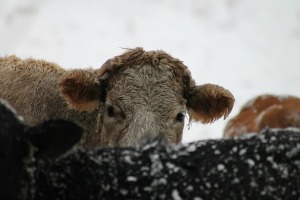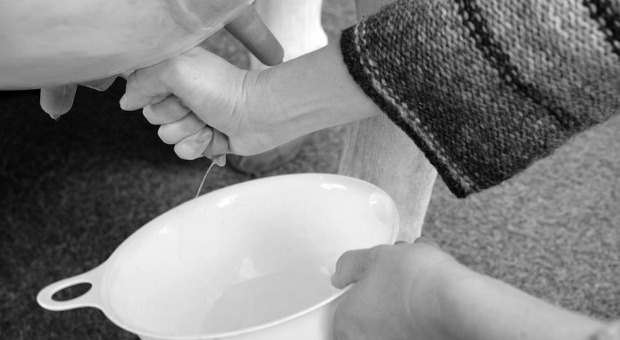Winter, in most parts of the US, is never a good time for animals. It’s cold and often wet, the days are short, and fresh grass is non-existent. It’s no wonder that milk production may slow down a bit.
For example, cows get stressed when it’s cold, and they don’t produce as much milk as cows that are comfortable. Routines change, it’s colder, the food is different, there are many factors that stress your cow, but the number one stressor is cold.
We talked about how to get more eggs. This time, let’s see what to do to boost your dairy cows and keep the milk coming in the freezing winter days!
1. Have Your Cows in Good Condition
 Before winter sets in, it’s important that your cow is in good physical condition.
Before winter sets in, it’s important that your cow is in good physical condition.
She needs to be at a good weight, and she needs time to acclimate to the cold so that she can grow her winter coat.
If she’s going to be outside for winter, leave her outside as the days grow shorter and the weather drops.
If she’s used to being in a barn during the summer, she’ll need to stay in it during the winter, too.
Assess your cows a couple of months before winter. Body fat is going to be one of the top two factors that help her stay warm. If you only have one or two cows, this obviously isn’t as difficult as if you have a herd.
Still, if your girls are a little on the thin side, increase their feed so that they’re carrying the right amount of weight heading into winter. This will keep them from stressing so much from the cold.
If they’re thin, they’ll use what fat stores they have to keep warm instead of giving milk. Thin cows may also produce weak calves, have problems producing colostrum, and take longer to come back into heat.
How your cow should look depends upon her breed and age – two year olds are the toughest if they’re breeding because she’s giving milk, growing, and eating to feed a baby, too. She may need A LOT of feed. Know your cows and know what they need.
On the other end of the spectrum, if your cow is obese, she’s not going to winter as well either. Just like people, obesity in an animal does not contribute to good health. Adjust feed as necessary.
In addition to keeping her milk production up, being at a good weight will also help her give birth easier if she’s pregnant, and will help her regain her weight and come into heat earlier after she gives birth.
2. Feed them Enough of the Right Feed
Throughout winter, your cows are going to need more food that they do during the summer. It’s also important that they have access to plenty of water and a salt lick as well.
Roughage – hay – is what helps a cow produce the energy she needs to stay warm and happy. If she doesn’t have enough hay, the weight will fall off of her.
This is because the fermentation and breakdown of the cellulose in the hay creates energy. High quality alfalfa may provide plenty of nutrients, but alone, it won’t provide enough roughage for your cows to stay warm.
You may not know it, (if you don’t, you should) but cows shiver. If they get that cold, they’re burning calories like mad. You need to avoid that. Give them plenty of hay.
Just so you know, a cow’s energy needs increase by anywhere from 17-50 percent after giving birth, so there’s a starting point for you.
Next, consider the temperature. A cow in good physical condition that has acclimated to winter by growing a good coat is good to go on regular winter rations until she reaches her critical temperature.
That temperature is around 20-30 degrees F. At that point, she’s burning fat to keep warm and you need to increase her feed in order to keep getting milk. A rough rule of thumb is to increase her rations by 1 percent for each 2 degrees below critical temperature.
Once the temperature drops below zero, she may be eating up to a third more than she would at 50 degrees just to maintain her body heat.
Don’t forget to factor in wind chill, length of the cold snap, and whether or not she’s wet. Even the best winter coat doesn’t trap body heat if it’s wet – imagine going outside in wet clothing.
3. Give them a Morning Boost
This goes along with feed, but I thought that it merited its own section because it’s just that important. If you’re counting on pasture to provide part of your rations, you may need to give your ladies a little push in the mornings with some hay to get them warm.
Even though there’s pasture available, if they’re cold, they’ll stand huddled to preserve body heat instead of going out to graze. Give them some hay in the morning to get their bodies producing heat and then they’ll go out and graze.
4. Build a Shelter
You know that even if it’s 40 or 50 degrees, if there’s a good wind blowing, you’re going to pull up your collar and huddle into your coat. If it’s raining, it’s even worse. It feels a lot colder than it actually is. Your cows feel the same way.
It’s important that your cows have shelter. If you don’t have to worry about much snow or wet, then a windbreak may do, but if it’s raining or snowing much, they need a at least a lean-to to shelter in. A barn is preferable. Whichever route you go, your cows need to have a warm, dry place to get in out of the weather if it’s cold.
If you keep them in a barn, make sure that it’s well-ventilated. Damp and moisture lead to respiratory conditions in cows.
If you’re getting a blizzard, you can partially close some of the vents to keep the snow from blowing in, but you want at least a half inch of open ventilation for each 10 feet of building width, no matter what.
Provide Adequate Bedding
If you have free stalls or lean-tos where your cows sleep, provide adequate bedding in them. This means that it should be dry and there should be enough to provide some warmth.
5. Protect Her Teats
Just like our delicate lips, faces, and hands get chapped in the cold, so do a cow’s teats.
It’s extremely important that you make sure that her teats are dry when she leaves the milking stall or feed area, and you should also provide windbreaks around the barn, too.
Bag balm is called that for a reason. It helps sooth bags and teats that may be moderately irritated.
Dip teats before milking and after milking. Though it adds a few seconds to the process, it’s worth it because it really does help reduce mastitis both directly by killing bacteria and because chapped, cracked teats inhibit the milk from dropping, which leads to infection.
https://www.youtube.com/watch?v=oD2hx0uyhMo
Video first seen on MonkeySee.
Use germicidal dips that also contain 5-12 percent skin conditioners. Don’t wash them because that washes off the natural protective oils, and make sure that the teats are dry before they leave the milk shed.
Warm, well-cared-for cows are happy, healthy cows who give lots of milk. If she’s stressed so much by being cold, or is so cold that she uses all her energy staying warm, or if her teats are chapped and sore, she’s not going to give good milk.
Your goals should be keeping her warm and healthy, and these are all steps toward that outcome.
Are you prepared for a coming food crisis? Click the banner below and discover how you can feed your family with healthy foods during any collapse!
This article has been wrriten by Theresa Crouse for Survivopedia.






















































































Comments 1